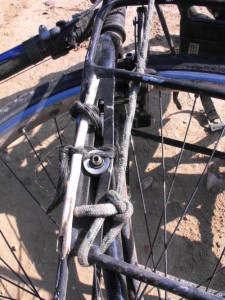Myth/ Intent/ Probability
For some reason the myth of the artisan- be it winemaker, machinist, or yes, even artist- as being someone with special creative powers and abilities seems to recur throughout history. Not that those people themselves aren’t even sometimes believers in these myths- they are. But the boring truth is that everyone has to deal with the physical world around us and therefore are all acting in accordance with certain physical laws. Physics, gravity, materials etc. are all externalities which we have to deal with on a daily basis. They usually don’t change much (although working in space, under water etc. can change things dramatically) and we base are ingenuity and survival on these constants. Prediction of them is at times vital as is the role of the precautionary principle.
The bicycle has been designed and redesigned for use on the earth. It might work reasonably well on the moon or under water but that is not where it’s many trials and revisions have occurred. Its’ human designed evolution has occurred be cause of our desire to move more quickly and efficiently than our legs might otherwise allow. Its form has arisen based upon our two legged bodies, brains, the planet and all of its physical properties. Just as definitions of words themselves have sometimes drifted over the years so too have many of the original reasons for procedural processes. Doing something out of habit- a learned behavior- can be effective but does little to describe the underlying reasons for doing them. In short: knowing something is not the same as understanding it. By being aware of our tendency to sometimes confuse these two we can better understand how to solve new problems we may encounter. The difference between being stuck on the
cause of our desire to move more quickly and efficiently than our legs might otherwise allow. Its form has arisen based upon our two legged bodies, brains, the planet and all of its physical properties. Just as definitions of words themselves have sometimes drifted over the years so too have many of the original reasons for procedural processes. Doing something out of habit- a learned behavior- can be effective but does little to describe the underlying reasons for doing them. In short: knowing something is not the same as understanding it. By being aware of our tendency to sometimes confuse these two we can better understand how to solve new problems we may encounter. The difference between being stuck on the  side of the road with a cut tire sidewall and being able to ride home on a tire
side of the road with a cut tire sidewall and being able to ride home on a tire  stuffed with grass, dirt or booted with a dollar bill requires creative thinking. If one is hopelessly stuck with the idea that a tire can not be ridden without a properly fitting tube, you could be waiting for a long time. Not all options may be worthy of consideration but all options are worthy of thinking. Mulling over and prioritizing all reasonable solutions should definitely be in the play book.
stuffed with grass, dirt or booted with a dollar bill requires creative thinking. If one is hopelessly stuck with the idea that a tire can not be ridden without a properly fitting tube, you could be waiting for a long time. Not all options may be worthy of consideration but all options are worthy of thinking. Mulling over and prioritizing all reasonable solutions should definitely be in the play book.
The human powered vehicle -or bike more specifically- was not always as it is now nor will it likely continue to be exactly as it is today. It has gone through many evolutionary steps and missteps and countless trial and error testing. Old or failed designs may be resurrected as new technologies, materials and insights are made. Some may need to be rediscovered entirely. And although the basic two wheeled bicycle seems to be the most common there are of course unicycles, three/ four wheelers, ski/ paddle “bikes” and who knows what else. What they do have in common is that they are all means of transportation; functioning according to circumstances dictated by our environment, our bodies physical morphology and limited by our brains’ imagination, available resources and cost restraints. We most often use them for transportation. Even the “for display only” type artwork bikes are basing their designs on something originally intended for motion. But let’s not digress too much more. Bikes are for travel- and art can be based on anything (and that’s not what this rambling is intended to cover).
As in just about all aspects of our lives we humans are constantly doing the mental calculus of weighing various options based on the information we have at hand. We cross the street after looking for cars based on the assumption that a car is the most likely thing to hit us and not say, an asteroid. This is learned and observably empiricial: We anticipate how the physics works because we’ve learned about it from our general experience and from others: step in front of a car and you’re likely to get hurt. We also might further rank these assumptions based on their probability. A car might be more probable than a truck or a motorcycle/ plane/ spaceship/ asteroid/ etc. We often do this without thinking much about it. But this process is a very important thing to be aware of. Not because it always works for us- we may use faulty information out of ignorance, expedience or simply have the misfortune of experiencing the unlikely- but because this rational, reasoned thinking process is what allows us to best succeed at solving the varied problems we encounter in the world. We in short, make guesses using probability with what meager capabilities we have at our disposal. How many variables we may be able to juggle at one time may depend not only on innate abilities but on practice and method. Imagine juggling on the moon. Little gravity/ atmosphere might allow you to throw up a large number of random objects- the trick being to know in what order they are falling back down and that they will all be effected by gravity in the same way. Not getting distracted by how overwhelming this might seem, or to resist looking for illogical answers (i.e. which objects are the same color, size or easiest to catch etc.) may be difficult. If the first objects to fall back down happen to be the same color we know this has little to nothing to do with the order in which we threw them. It becomes more difficult to make these distinctions with more complex and varied systems. Keeping your eye on the ball includes keeping your eye on your mind. Choices made for solving real world problems should reflect these external realities.
Why mention the above
Well on the myth front it seems necessary to dispel the claim that good surgeons, winemakers, machinists, or artists don’t base their abilities on a learn-able method. For those of us who are able to walk, we have based this means of movement on the continuing effects of gravity and our bodies two legged form. We are also most adapted to a land based environment. We can swim, fly and the like but not without difficulty. Our brain has adapted to let us build a helicopter but it isn’t easy. We may use hope, wishing, or intuition as an impetus to complete projects but not as a means to solve problems. Learning and remembering facts and figures is extremely important- but recognizing that problem solving is best based on the universals experienced in the real, external world will help in solving just about any problem we may face. This awareness will help from becoming mired in the illogical traps that our minds can often project- be they over optimism or complacent immobility.
Knowledge of this will help one cut to the chase- so to speak- and avoid being overly distracted by what our brains are so good at doing: naming and categorizing things. And here I don’t just mean to refer to a language based categorizing. Our brains actually rifle through their knowledge base and try to compare and contrast things we encounter on the fly. However if we are truly to utilize our brains imaginative potential it is good to avoid the pitfalls it brings when this process is left unchecked. Knowing somethings name has little to do with figuring out how to solve a mechanical problem for instance. It may be helpful to know these things but they have nothing to do with figuring out the underlying intent (purpose) of things. One can still fully function in the world even when working in a foreign country. Physcics, gravity etc remain the same. Communication and social norms may differ but the original intent of a broken part remains constant no matter what word it is described by. It was designed to function in accordance with the physical laws of the planet.
Why care about intent/ purpose? Here is a bike related example:
Let’s say someone want’s work done to their 1970’s Gitane road bike which is in horrible shape. It has a broken axle held together with a barely functional quick release, square bearings, belled out head tube, frozen french threaded parts etc. You ask them if it has sentimental value because it will be extremely expensive if not impossible to fix. They say, “But it’s a Gitane?! Aren’t they great bikes?”. Your brain races to mull over all the likely information they might need/ want and present it in some sort of order of importance: “Well, if you’re going to use this bike for daily commuting it won’t be the most reliable, cost effective or efficient use of your time and resources” You might, if needed, elaborate: ” For 1972 this bike was quite a bright star. Lighter and quite reliable compared to others in its price range. Today however, given its age, plastic derailleurs, cottered cranks, freewheel equipped rear hub and expensive to non-existant french sized parts, this bike is best relied upon as little as possible. For better or worse a new inexpensive department store bike would, at this point, be a more reliable, repairable and cost effective option if you intend to ride it. But it depends on what you want to use it for: commuting or a weekend trip to the store”. In short, we’re doing our best at guessing the customer’s wishes and intent based on the presumption that bikes are first and foremost needed and used for transportation etc. Sometimes what someone wants (i.e. a reliable and useable bike) and the thing they think is best to get there (not knowing what the reliable options truely are) are at odds. Some folks may be hung up on the whole name/ country of origin/ hand made thing. The whole reason they might be attached to the bike in the first place might be based solely on its name, origin and that it is being recycled back into general use. A name and implied reputation may be a good way to make a quick value judgement of something. Gitanes may have once been the best bike the local shop had to offer and therefore are more likely to be generally good bikes. But what is the actuall overall condition of this bike? This model? What are the full range of alternatives available today? How much do they cost? The customer may have in fact gotten the bike for free or it may have sentimental value but relying on the premiss that a bike is firstly intended to be ridden seems a good place to start as assumption number one. What something is named has no bearing on what it actually is. If the name or look of a bike is to take precedent over a bike’s intended purpose, then this should be pointed out. Nomenclature is just an organizational tool. It should in no way obscure the most usual objective of having a reliable machine that lives up to its intent: to be be ridden. But some folks will still cling to nomenclature as a means to an end. If the idea is to just look the part, the “coolness” of a bike from one of the industries’ heydays may be more important than other more reliable and reasonably priced options. There often will need to be compromise between these two at times competing sides of the coin; but be sure to emphasize the hazzards of taking such a dinosour on a tour of France. The “coolness” factor might even be negated in that case.
Probability
In generall terms we humans with our big brains are quite good at guessing outcomes. We can design things from mousetraps to computers often almost entirely on “paper”. We have numerous virtual reality testing programs to try and reduce the chance of failure and lastly, can often test them in the real world. However nothing is perfect and the more complicated the device, the more rigorous the testing needs to be to prevent premature failure. Ideally one might want to run a program so complex on a computer so fast, that we virtually eliminate any chance of error. This of course is, for all intents and purposes, an unobtainable- if not prohibitively expensive- ideal. Simpler or less important devices may not require as much testing while complex ones, where lives may be at stake, should require more. But we only have so much time, money and recources, so designing models that most accurately reflect the real world scenarios they will be used in is another science in itself. It would be prudent to test a new cancer drug on similar species and ultimately humans before we might ever test it on a tree say. We rank these choices based on the likelyhood- probability- that they will help in achieving the desired outcome. Sometimes a chosen method is faulty- visually whales are more dissimilar to us than fish but we are more genetically similar to whales. The visual assumption that whales and fish are similar was incorrect at least so far as the actual “under the hood” genetic items concern us. But back to bikes. Basing one’s oppinion on the flashyness of the paint: “wow somebody really spent a lot of time on this! It must be good.” or “golly, I’ve heard that they really know mountain bikes in the U.S.A. and this full suspension Magna looks so exotic”, might be quick ways to make a somewhat informed decision. But what it is and what it looks like may be two different things. The paint/ name might not matter much unless you are a collector. And what’s collectible is quite subjective. What works well is not. This is in no way to put down collectibles, but solely to help illustrate the difference between two often unrelated purposes: to be seen and to be used.
